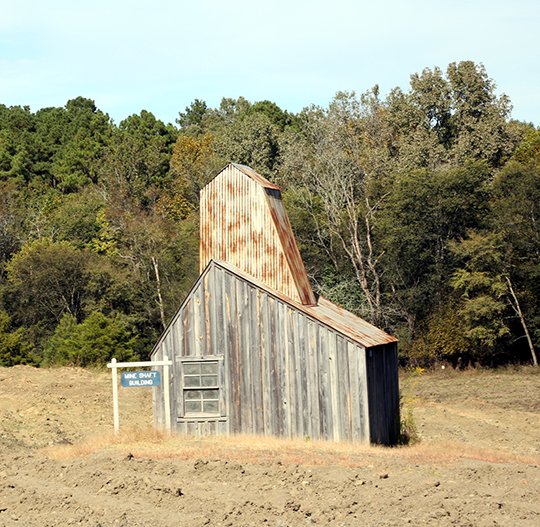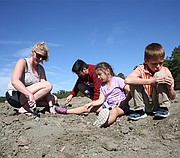Outdoor writer and photographer Corbet Deary is featured regularly in The Sentinel-Record. Today, Deary writes about Crater of Diamonds State Park.
As the annual deer season nears, many will spend as much time as possible in Arkansas' forests. There are others, however, who are not comfortable in an environment where literally thousands of hunters are gathered.
Although I will be among the avid hunters, I do understand the sentiments of those who would rather avoid the masses. That in mind, I thought this would prove a perfect time to cover a destination where non-hunters can still enjoy the outdoors in an environment where hunting is not allowed.
Hunting is not allowed in any of the 52 state parks scattered throughout Arkansas. Each and every one of these destinations is worthy of mention. And I suspect I'll cover several of these destinations in the weeks to come.
But there's one park, in particular, that has something special to offer. In fact, Crater of Diamonds State Park is the only diamond-producing location throughout the world where folks are welcomed to do a little prospecting (for a small fee) and allowed to keep their findings, regardless of its worth.
Located near the town of Murfreesboro, the park also sports other outdoor opportunities, as well. But let's begin with what draws folks to the facility from abroad. That's right, let's talk diamonds.
According to information posted on the Arkansas State Parks' website, a "massive volcano" brought diamonds to the earth's surface at this location many years ago. The first diamond was found on this plot of land in 1906 by the landowner, John Huddleston.
Literally thousands of diamonds, an excess of 75,000, have since been located on this 37-acre plot of land. According to the state park's website, an average of more than 600 diamonds are found at this location on an annual basis, some of which have been of impressive stature.
The largest diamond found in North America actually came from this particular site in 1924. Referred to as "The Uncle Sam," it weighed 40.23 karats. There have been a number of other notable finds at the mine throughout the years. Found in 1956, the "Star of Arkansas" weighed in at 15.33 karats. And the 16.73-carat Amarillo Starlight was found on the site in 1975.
Eight other diamonds weighing more than 5.4 karats have been plucked from its soils throughout the years, as well. And let's not forget about the Strawn-Wagner Diamond that was found at the state park in 1988. Although only weighing 1.09 carats, the diamond was revered by the American Gem Society as a "D Flawless 0/0/0 perfect diamond." American Gem Society Laboratory Director Peter Yantzer referred to the gem as a "one-in-a-billion" diamond.
One might think the landowner and his family would hold on to the land, as they knew these much-coveted gems lurked in the sandy soil, but not so. In fact, this piece of property has changed hands several times throughout the years. And with each transfer of the deed came unsuccessful attempts at commercial mining.
There were many reasons for failure, including "lawsuits, lack of funds, fires and mysteries," to name a few. The property was operated as a tourist attraction by private entities for 20 years beginning in 1952. However, the state purchased the property in 1972 with intentions of developing a state park.
Well, the state park was obviously a hit, as folks have since traveled to the park from abroad in anticipation of bringing home the proverbial bacon. And although a majority of the people who visit the park go home with nothing more than dirt under their fingernails, the site is still coughing up its fair share of diamonds. In fact, more than 30,000 have been found since the state park was declared open for business.
A young girl found a diamond only one day before our most recent visit. And according to state park employees, more than 300 have already been located on the site this year.
So how does one go about digging for diamonds at the state park? Well, it's very easy. Stopping in at the visitor center, one might get a little better acquainted with the facility via interpretive stations upon arrival.
Those eager to get out and try their hand at prospecting will then embark upon a short walk to the Diamond Discovery Center, where they can see diamond and geology exhibits, and rent the necessary tools to be most effective. And I would suggest making a restroom stop at either the visitors center or Diamond Discovery Center, as there are no restrooms at the 37-acre field where folks dig for diamonds.
Of course, one can walk back to the center's restroom anytime they please. But who wants to detour their focus of finding precious gems once in the field?
Although closed for the season, the Diamond Springs Water Park is also located within the perimeters of the state park's property lines. This is also a very popular destination during the summer months.
Hiking enthusiasts might also find the facility of interest, as three trails meander through the park. The Campground Trail only consists of 0.2 mile as it makes its way through a wooded area separating the visitors center and campgrounds.
The River Trail however, is somewhat more lengthy. Beginning at the camping area, the path winds through a predominantly pine forest to the banks of the Little Missouri River before looping back to the trailhead 1.2 miles later.
The Prospector Trail also consists of 1.2 miles of dedicated path. This particular route begins at the back side of the minefield and makes a loop through several "unique geological features" during its journey.
Camping enthusiasts also find the park of interest, and rightfully so. Each campsite is located under the shade of towering pines. The park offers 47 Class AAA campsites, each sporting a 50-amp electrical service, water and sewer hookups.
Five other sites have been designated specifically for tent camping. Although primitive campers find pleasure in getting by with the bare necessities, I suspect they will be most appreciative of the water services at the primitive camping location. And of course, the bath house that is located within the perimeters of the camping area is always well accepted.
As for myself, I anticipate getting out and sharing the forest with my fellow hunters. But I am also proud to reiterate that there are locations where non-hunters can still enjoy the outdoors at locations where hunting is not allowed. And I can't think of a better location to avoid the masses of hunters than one where outdoor enthusiasts stand a chance of locating and taking home a gem that is cherished throughout the entire world.
To get to the state park from Hot Springs, travel west on Highway 70 to Kirby and veer left onto Highway 27 north. Travel 15 miles to Murfreesboro and make a slight left at the courthouse square. Turn right onto South Washington Avenue and travel 2 miles to the park's entrance on the right-hand side of the road.
Sports on 10/22/2017

